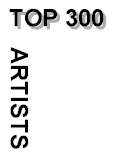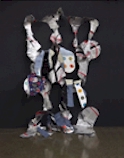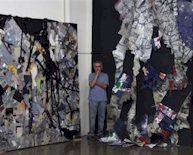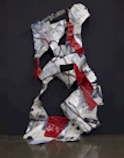The celebrated Dutch painter Karel Appel, a pioneering expressionist artist in postwar Europe, died at age 85 in ZŁrich on May 3, 2006. A memorial was held for him at the Concertgebouw in Amsterdam on Sept. 23, from which the following remarks are taken.
Itís never easy to say goodbye in public to someone whose influence and inspiration has been so profound on oneís own life. When Harriet Appel called shortly after her husband Karel died to ask if I might speak at Karelís memorial -- held in October 2006 at the formidable shrine of Amerstamís famous Concertgebouw -- I could only think of how many others (perhaps too many of them already passed) would be more suited to the task. Hearing the wonderfully crafted tributes read by Michel Ragon, who edited the seminal CoBrA magazine back in the 1950s, and the eminent Rudi Fuchs, who during his tenure as director of the Stedelijk Museum did much to position Appel as Hollandís greatest artist of the 20th century, I was not simply humbled by the honor of following them but also perplexed by how my friendship with Karel had somehow put me in this good company.
Harriet explained to me that between us, we represented the three cities Karel had lived in and loved in his life -- Paris, Amsterdam and New York. We also represented three distinctly different generations whose lives and sensibilities he had touched. What she did not tell me until after I improvised a rather glib anecdotal account of our friendship was that in fact we also represented the three sides of Karel -- poetic, serious and comical. It would seem that in his ingenious way Karel Appel smiled upon me as the perfect dupe to embody the latter of these wonderfully intertwined attributes.
Karel was one of the dearest characters Iíve ever known. I canít help but thinking Karel would be chuckling to himself now. Always gracious in any occasion, you knew that he was far too informal to vest much attention in ceremony. Maybe heíd just laugh seeing me here today, in my fine suit, for I canít imagine that he ever saw me attempt to outfit myself in anything more substantial than a tee shirt and jeans.
Iíd also guess that Karel would remember the first time he asked me to say some words on his behalf. It was at some grand function in his honor, certainly a major show of his work, but a show in one of those provincial cities -- Buffalo or Baltimore, perhaps (we went to both Iím sure, but it could be another capital ĎBí), places where culture is more special. You know, where culture is not part of everyday life but a real occasion.
Perhaps it was his modesty or maybe his peculiar sense of humor, but as we were sitting together Karel asked if I might act the art critic and speak for him. No doubt Iíd had some wine already, but it was probably more a combination of fear and folly that made me stand up before his adoring public and introduce him, saying "Karel Appel is a clown."
It seems I specialize in the faux pas, and though the rest of my remarks are now only a blur in my memory, Iím confident that I spent the next several minutes trying to explain why this was not a bad thing, but something very great indeed. In hindsight it seems that what I was getting at was that we know that our world needs more than ever irreverent, iconoclastic jesters. For this Karel Appel will be deeply missed.
To be honest, I might have to live as long as Karel did to be ever as youthful as he was. But the youth we shared, mine in body and his in heart, was exactly what so many people of my generation, struggling to forge our own identities, received as blessings and knowledge from this master of mischief.
Itís sometimes not so easy to remember the glorious farce of being young. How Karel managed it for 85 years is but another mystery. Iím lucky to have my son to remind me of what itís like to be so smart and so foolish at once. The great thing about being young is that combination of knowing better yet knowing so little. It makes the young inherently revisionist.
Of course, when our gang met Karel Appel he was famous, already set in the pantheon of Modernism. To find that he was so open and supportive was not just a revelation, it was a lesson in being. Not only did his democracy rub up against our received hierarchy of greatness, it informed us of a spirit and vitality that was trans-generational.
History will work with its usual simplistic clarity: Karel Appel will forever be known as the co-founder of CoBrA, that first significant art movement of post-war Europe. But what else was born then? Youth culture.
Before the immense social and cultural disruptions of the war, youth was wasted on the young -- meant to be seen and not heard. In America, the veterans of that war are called "the greatest generation." To those of us who do not live by flags and anthems, however, Karelís generation is the subversive germinal spirit of our underground.
From Karel and his gang of friends, jazz musicians and Beats, artists and poets like Larry Rivers and Allen Ginsberg, we had direct access to the "who, how and why" some people do not live by the rules. In time and place, that was always Karel Appelís New York.
Karel loved New York, for its creative community of course, but also for the chaos and the madness, and especially the overwhelming polyglot culture of so many diverse peoples navigating this single congested space.
I remember him telling me, as we were walking through the bustle one afternoon, how all those different languages and ways of being inspired him. I thought of that conversation again years later, after Karel and Harriet had moved up to the country, when I went with my mother and brothers to visit them in Greenwich, Conn. He was making these monumental assemblage sculptures -- explosive mounds of urban detritus alchemically made magical -- that to me then captured the very essence of that Manhattan Tower of Babel he had thrived in.
The official, institutional version of Karelís art casts it as savage and brutal and raw and primal. The violence of war, some grand expression of our collective rage. But to me, his art was always first and foremost an expression of his immeasurable love for life, filled up with his vitality, his passion and his intensity, true, but always wrapped in his kind embrace.
A quick story, a little rude, but suitable, I think -- Karel had decided to celebrate his 70th birthday at this out-of-the-way restaurant in a tinselly Chinatown shopping mall down on East Broadway on the Lower East Side. This building had an escalator, and on the top floor was this ornately elegant Chinese restaurant. Karelís party had a private room, and had present quite a mix in terms of generations, from Allen Ginsberg to young artists.
Well into the meal there was this commotion, as a flock of red-suited Chinese waiters chased after a man who had barged into the room with a big scuffle. Everyone was startled, but Karel just looked up and said, "Gregory"-- it was Gregory Corso -- "I hope you didnít have trouble finding the place."
Corso turned to the stunned waiters and scowled, "Not at all, itís right across the street from my methadone clinic." So that was it, not just smiling social grace, but a man who, no matter what surprises life might throw at him, remained impossibly unflappable.
CARLO MCCORMICK is contributing editor to Paper Magazine. -Source: artnet.com





 Find
out how much an artwork of Karel Appel is worth
Find
out how much an artwork of Karel Appel is worth


